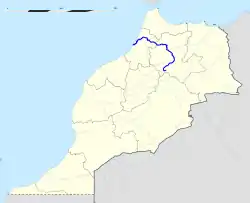Sebou River
Sebou (Berber: Asif en Sbu, Arabic: سبو) is a river in northern Morocco. At its source in the Middle Atlas mountains it is known as the Guigou River (Berber: Asif n Gigu).[1] The river is 496 kilometers long and has an average water flow of 137 m3/s, which makes it the largest North African river by volume. It passes near the city of Fes and discharges to the Atlantic Ocean in Mehdia. Sebou is navigable for only 16 km as far as the city of Kenitra, which has the only river port in Morocco. Its most important tributaries are the Ouergha River, Baht River and Inaouen River. The river supports irrigation in Morocco's most fertile region: the Gharb.
| Sebou | |
|---|---|
 Location of the Sebou River in Morocco | |
| Location | |
| Country | Morocco |
| Physical characteristics | |
| Source | |
| • location | Middle Atlas |
| Mouth | |
• location | Atlantic Ocean |
| Length | 496 km (308 mi) |
| Discharge | |
| • average | 137 m3/s (4,800 cu ft/s) |
History
Sebou was known in antiquity as Sububus. Pliny the Elder states that it was "magnificus et navigabilis" (grand and navigable), flowing near the town of Banasa.[2][3]
In 1669-1670, the Alaouite sultan Moulay Rashid built a bridge over the river near Fes which has been preserved today.[4]:28[5][6][7]:410
Environmental issues
A number of water pollutants enter the Sebou River, notably including pesticides and fertilisers from agricultural runoff and untreated sewage from towns along the river.[8]
See also
References
- "Sebou River". Encyclopædia Britannica. Retrieved 2 December 2012.
- Pliny the Elder. Natural History, book V (in Latin). Retrieved 6 January 2019.
- Natural History, book V, translated.
- Gaudio, Attilio (1982). Fès: Joyau de la civilisation islamique. Paris: Les Presse de l'UNESCO: Nouvelles Éditions Latines. ISBN 2723301591.
- "Pont Oued Sebou". Inventaire et Documentation du Patrimoine Culturel du Maroc (in French). Retrieved 28 July 2020.
- Le Maroc de 1631 à 1812: extrait de l'ouvrage intitulé "Ettordjemân elmoʿarib ʿan douel elmachriq ou ʿlMaghrib de Aboulqâsem Ben Ahmed Ezziani. Translated by Houdas, Octave Victor. École des langues orientales vivantes. 1886. p. 21.
- Marçais, Georges (1954). L'architecture musulmane d'Occident. Paris: Arts et métiers graphiques.
- Thieme, Michele & Abell, Robin & Stiassny, Melanie & Skelton, Paul. (2005). Freshwater Ecoregions of Africa and Madagascar: A Conservation Assessment. Bibliovault OAI Repository, the University of Chicago Press. 1-431.